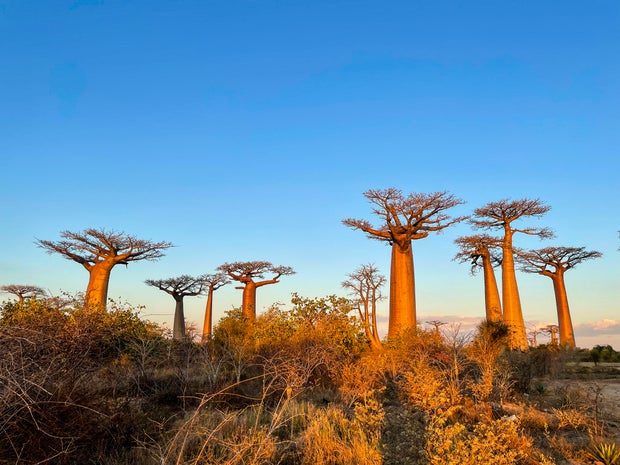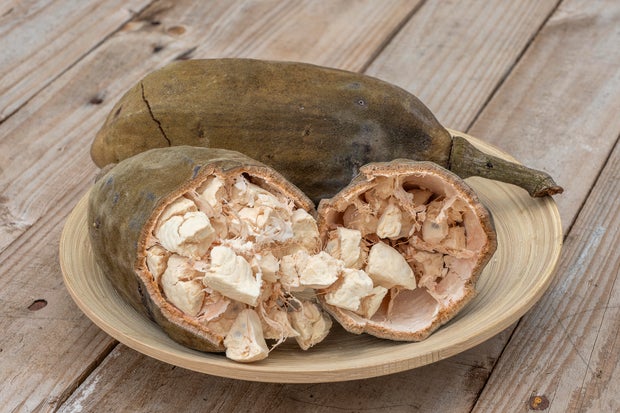The “grotesque” baobab tree has historically been considered the “tree of life” in arid regions because of its ability to establish and maintain its own ecosystem. The origin of what scientists regard as “among the most charismatic species on Earth” has been a subject of admiration since the ancient Egyptians; however, it has remained unknown until recently.
At present, there are eight species of tall, broad-trunked plants, which are also known as “inverted trees” or “mother of the forest.” Madagascar is home to six species from each of these groupings; one species is found throughout continental Africa, while the other is unique to northwestern Australia.
Nevertheless, each of these locations has a unique, authentic origin.
The DNA of the species was analyzed to resolve the mystery surrounding the “extraordinary trees,” as per researchers. In a recently published study in Nature, they asserted that Madagascar, an African island nation, is the origin of all trees. The revelation elucidates the evolutionary lineage of these exceptional species.
Madagascar is the location of Baobab Avenue.
The study asserts that baobabs have “captivated botanists, travelers, naturalists, and bystanders for centuries.” “The earliest evidence that humanity admired these magnificent trees dates back to approximately 2,300 BC, when the Ancient Egyptians were at work.” Baobabs have become one of the most captivating species on the planet for their putative durability, extensive functional range, and monstrous stature.
It was difficult to acquire that charisma. However, scientists have claimed that they have effectively determined the location of their common progenitor to be Madagascar through the process of genome analysis and leaf collection. Hybrid species with unique flowers that attract a diverse array of other animals were developed as members of the species progressively dispersed from the island.
Prof. Andrew Leitch of Queen Mary University of London expressed his enthusiasm for participating in this project, which uncovered the remarkable long-distance dispersal of two species, one to Africa and the other to Australia, and the patterns of baobab speciation in Madagascar. “This was accompanied by the development of some intriguing pollination syndromes that involved bats, lemurs, and hawkmoths.”
In Tanzania’s Zanzibar, which is situated in east Africa, the baobab fruit, or puree, plate, and pulverized Adansonia digitata, is considered a superfood.
Baobabs are “exceptional,” as per the San Diego Zoo Wildlife Alliance.
A spherical, robust trunk is formed to sustain the elongated branches. “The organization explains that the bare branches of baobabs, which are deciduous trees, resemble gnarled roots during the dry season (which can last up to nine months). This gives the appearance that the trees were pulled up by their roots and put back inverted.”
The alliance maintains that trees are not only essential to their respective ecosystems, but they also produce their own. In addition to preventing erosion, facilitating nutrient recycling, and maintaining soil moisture, they provide shelter, sustenance, and water for other species.
The minimum height of a baobab species is sixteen feet, while the maximum height and circumference of the trees can reach approximately 82 feet and that, respectively. In contrast, the average length of a semitruck is 72 feet.
However, numerous of these trees are currently involved in a conservation battle. The study indicates that all species except for one are listed on the IUCN Red List of Threatened Species. Three of the species are classified as endangered, one as critically endangered, and one as threatened with extinction. Despite the fact that its populations are declining, a single species is classified as “least concern.”
The DNA results suggest that specific trees are deficient in genetic diversity, a factor that is essential for the survival of species as it enables the development of resistance to environmental changes. Furthermore, their research suggests that climate change will “pose severe threats” to a species that is indigenous to Madagascar and may even result in its extinction before 2080. The study’s researchers say that their findings necessitate a reevaluation of the conservation status of baobabs.
Furthermore, the Wildlife Alliance of the San Diego Zoo documented a “rapid rise” in the mortality of trees in southern Africa.
According to the organization, nine of the continent’s 13 greatest baobabs have collapsed and perished. “The exact cause of the demise of these trees is uncertain; however, scientists fear that global climate change may be contributing to the situation.” Trees are an essential element of the African culture and environment.


